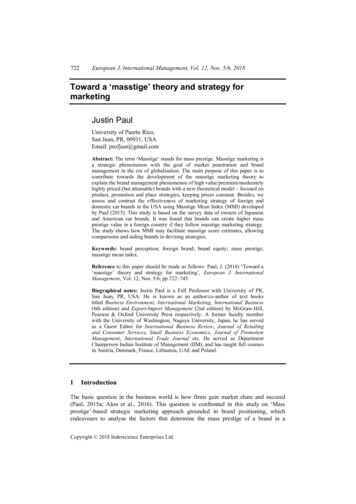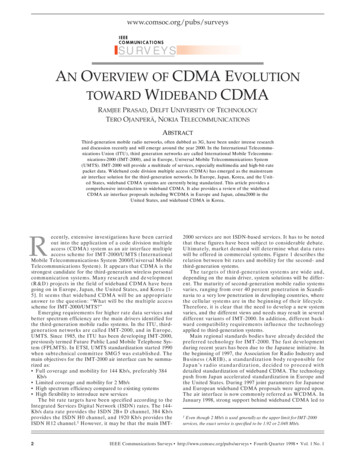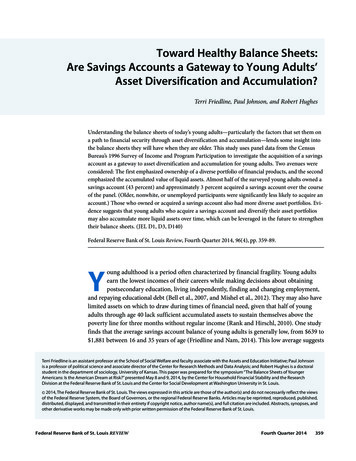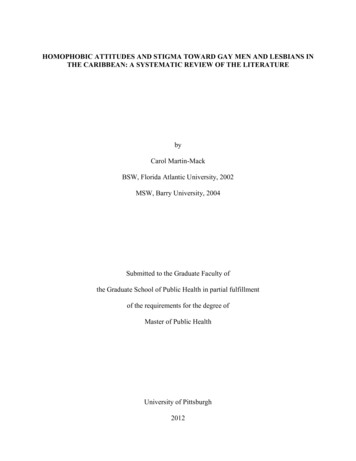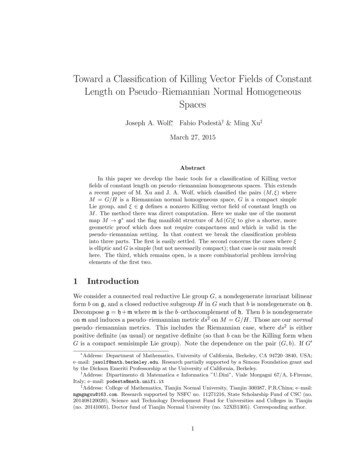
Transcription
Academy of Managemenl Journal1990, Vol. 33. No. 1, 199-209.TOWARD THEORY-BASED MEASURESOF CONFLICT MANAGEMENTEVERT VAN DE VLIERTUniversity of GroningenBORIS KABANOFFUniversity of New South WalesThe theory of the managerial grid, a model of interrelations amongstyles of management, was used as the criterion for validating the twobest-known self-report measures of conflict management styles. We reanalyzed six studies that used those measures and found thai bothappeared to be moderately valid. However, the measures failed to reflect the underlying tbeory in a few respects, which suggested specificareas for improving tbem.Blake and Mouton's (1964) managerial grid has recently made a strikingcomeback as a leading thesis in the literature an conflict management (Kabanoff, 1987; Pruitt & Rubin, 1986; Rahim, 1986; Shockley-Zalabak, 1988;Van de Vliert & Prein, 1989). Most authors have treated the managerial gridas a five-category scheme for classifying hehavioral styles or modes of handling social conflict. In our view, however, the grid expresses a more basicscientific theory. The reasoning behind this view follows.First, Blake and Mouton (1964, 1970) theoretically specified the similarities and differences among five styles of conflict management, proposingthat the styles varied on two dimensions—concern for people and concernfor production. They devised 9-point dimensions, with 1 representing minimum concern and 9, maximum concern [see Figure 1). Other authors havelaheied the two dimensions differently (e.g., Rahim, 1983a, 1986; ShockleyZalabak, 1988; Thomas, 1976), but the basic assumptions have remainedsimilar. People are classified into the five styles on the basis of which of thefive two-dimensional locations in the grid they psychologically occupy.Blake and Mouton define the respective styles as follows: avoiding, 1 onpeople concern, 1 on production concern; accommodating, 9 on people concern, 1 on production concern; compromising, 5 on people concern, 5 onproduction concern; competing, 1 on people concern, 9 on production concern; and collaborating, 9 on people concern, 9 on production concern. It isimportant to note that the styles are viewed as specific points defined hy thetwo dimensions and not as areas.The second reason for viewing the managerial grid as a scientific theoryThe authors are grateful to two anonymous reviewers for their helpful comments.199
Academy of Management JournalzooMarchFIGURE 1Theoretical Interrelations Among Five Styles of Conflict Management inTerms of Two DimensionsCOMPETINGCOLLABORATING9 8a.2tj oB.5oACCOMMODATINGAVOIDING1 23456Concern for peopleis that its originators conceptualized the two 9-point dimensions as intervalrather than ordinal scales. Blake and Mouton called the intervals "units ofdirection" (1981: 442) and introduced a two-digit coding system in which,for instance, "9, 9" represented nine units of concern for people combinedwith nine units of concern for production. Other authors have implicitly orexplicitly adopted their interval view by adding or subtracting an individual's scores on the two dimensions (e.g., Bobko, 1985; Chanin & Schneer,1984; Ruble & Thomas, 1976; Van de Vliert & Prein, 1989).Third, Blake and Mouton (1964,1970,1981) did not interpret the stylesas simple additive combinations of people and production dimensions. Instead, they viewed each style as a distinctly different compound resultingfrom an interaction of the two underlying dimensions. Thus, the two dimensions composing a given style cannot be separated (Blake & Mouton, 1981:441).Fourth, the theoretical distances among the five behavioral styles arespecifiable geometrically. Figure 1 presents the conflict management grid asa square matrix that has sides 8 units long and compromising at its midpoint.There are four distances of 8 units: avoiding to accommodating, accommo-
1990Van de Vliert and Kabanoff201dating to collaborating, collaborating to competing, and competing to avoiding. Those four styles are equally closely related to compromising in tbecenter, with a theoretical distance of 5.66 in eacb case. Maximally differentrelationsbips occur between avoiding and collaborating and between accommodating and competing, with theoretical distances of 11.31.Tbomas and Kilmann (1974) and Rahim (1983a) have published tbe twobest-known questionnaires that people can use to describe tbeir perceiveduse of the grid's five styles of conflict management (for a critique of theexbaustiveness and representativeness of tbe styles measured, see Knapp,Putnam, and Davis, 1988). A number of previous studies bave assessed tbevalidity of tbese instruments by means of empirically derived criteria (Cosier& Ruble, 1981; Kabanoff, 1987; Rahim, 1983a, 1983b; Ruble & Tbomas, 1976;Thomas & Kilmann, 1978; Weider-Hatfield, 1988). Tbe next section of tbisarticle briefly reviews results of tbese studies. Tbe study reported bere represents a new approach to construct validation of the Thomas and Kilmann(1974) and Rahim (1983a) operational definitions of the conflict management grid. We used the grid's theoretical pattern of ten distances amongconflict styles as our validation criterion. Data came from a secondary analysis of six studies tbat used eitber Thomas and Kilmann's or Rahim's instrument.METHODSInstrumentsThomas and Kilmann's Management Of Differences Exercise (MODE)(2974) is an ipsative questionnaire consisting of 30 sets of paired items,witb each item describing one of tbe five conflict styles included in tbemanagerial grid. A person's score on eacb style is the number of times he orshe selects statements representing that style over otber statements. TheMODE styles appear to have rather low levels of bomogeneity: across studies, Cronbacb alphas have ranged from .34 to .91 witb a mean of .58. Theirstability also appears low, witb test-retest reliabilities ranging across studies from .37 to .90 with a mean of .63. However, tbe level of social desirability bias affecting tbe measures also appears iow (Kilmann & Tbomas,1977; Womack, 1988). Support for tbe MODE'S validity includes demonstrated correlations between the five styles of conflict management and thetwo underlying dimensions (Ruble & Tbomas, 1976) and demonstrated correlations between MODE scores and scores on other, related instruments(Brown, Yelsma, & Keller, 1981; Kilmann & Thomas, 1977). However, Kabanoff (1987), wbo used peer ratings of conflict behavior as criteria, failed tofind evidence of external or predictive validity. Ipsative measures cannot vary independently—that is. they systematically affect eachother. Womack (1988) has discussed that the MODE'S ipsative nature severely limits the type ofstatistical analyses that researchers can use.
MarchAcademy of Management /ournaJ202TABLE 1Characteristics of the Studies AnalyzedStudyNInstrumeat UsedO'Reilly and Weitz (1980)Mills. Robey, and Smith (1985)Kravitz (1987)Rahim (1983a)Kozan (1986)Weider-Hatfield and Hatfield he Rahim Organizational Conflict Inventory (ROCI) (Rahim, 1983a) isa series of 28 5-point Likert scales, with high values representing high use ofa conflict style. The ROCI styles form an instrument that is internally consistent (a .50-.95, X .74), stable (test-retest reliability .60-.83, x .76), and rather insensitive to social desirahility response sets (Rahim,1983b; Weider-Hatfield, 1988). The ROCI's ability to discriminate betweengroups known to differ in their conflict styles, its meaningful relations withother conflict constructs, and its associations with measures of organizational effectiveness and climate have provided evidence for its validity (Rahim, 1983a, 1983b, 1986; Weider-Hatfield, 1988).Secondary AnalysisOnly six studies satisfied the three requirements we established forinclusion in our reanalysis. These studies (1) used the MODE or ROCI instrument, (2) assessed managers' reports of how they handle organizationalconflict, and (3) reported the ten intercorrelations among the five styles ofconflict management. Table 1 identifies the six studies analyzed. We decided to use a distance measure based on correlations rather than raw scoresor means because the latter are more susceptible to contamination by socialdesirability factors (cf. Kilmann & Thomas, 1977). Our criterion for judgingthe validity of each study's pattern of ten intercorrelations was the corresponding pattern of ten theoretical distances shown in Figure 1. If the MODEand ROCI instruments were perfectly valid, the intercorrelations betweencompromising and the other four styles would have the highest positive [orleast negative) values because those correlations represent the shortest distances. Similarly, the two intercorrelations corresponding to the two longestdistances (avoiding-coUaborating and accommodating-competing) would bethe most negative. Finally, the four intercorrelations corresponding to thefour intermediate distances (avoiding-accommodating, accommodatingcollaborating, collaborating-competing and competing-avoiding) would fallbetween the other two subsets of correlations.The reanalysis had two steps. The first was a validity assessment conducted by calculating Spearman rank correlations, corrected for ties of identical values, between the ten intercorrelations among conflict managementstyles (the MODE or ROCI score in a particular study) and the ten theoretical
1990Van de VJiert and Kabanoff203distances derived from the conflict management grid (the validationcriterion). This analysis indicated how valid each instrument was in termsof the similarity between the pattern of empirical associations among thefive styles and the theoretical pattern of associations the grid specifies.The second step explored how much each of the five different stylescontributed to the overall validity of the MODE or ROCI. In this exploration,we used a nonmetric distance-scaling program, called MINISSA, designedby Lingoes and Roskam (1973). The purpose of the procedure is to find aconfiguration of points whose Euclidean output distances reflect as closelyas possible the rank order of the input dissimilarities. Like a Spearman rankcorrelation analysis, this scaling analysis is a robust procedure that does notrely on the assumption that the conflict management grid provides precisedistances on interval scales. Applying Lingoes and Roskam's procedure to aset of ten MODE or ROCI intercorrelations resulted in a two-dimensionalrepresentation of the five styles of conflict management. This visual patternof empirical relationships, based on correlations among styles in the MODEor ROCI instruments, can be compared directly to the pattern of theoreticalrelationships that provide the validation criterion (Figure 1).RESULTSThe last column in Table 2 reports the Spearman estimates of the relationship between each study's ten intercorrelations among the conflict stylesfrom the managerial grid and the corresponding ten theoretical distances.The coefficients indicate that MODE predicts 9 to 36 percent of the varianceimplicated by the theoretical pattern of the conflict management grid andROCI predicts 24 to 35 percent of the variance implicated. Four coefficientsare insignificant, and two reach a .05 level of significance in a one-tailed test.In view of these low levels of significance, it seems important to consider themagnitude of the correlations (x - .50), given the small numher of degreesof freedom. In interpreting the results, we also took into account that the tenintercorrelations among the styles are not independent. Table 2 shows thatan ipsative questionnaire like the MODE produces negative dependenceamong its correlations, whereas the Likert-type items of the ROCI producepositive dependence among them. Consequently, the validity coefficientsmay actually underestimate the MODE'S true relationship with the conflictmanagement grid and overestimate the ROCI's relationship (cf. Schiffman,Reynolds, &. Young, 1981: 258). Therefore, we concluded that overall, theMODE and ROCI are moderately valid measurements of the grid-based managerial conflict styles. There were two reasons to apply a Spearman rank correlation rather than a Pearsonproduct-moment correlation. First, because tbe criterion has only three values or distances—5.66. 8.00, and 11.31 — the Pearson coefficient underestimates the validity of an instrument.Second, the Pearson coefficient requires measurement at an interval level, but the Spearmancoefficient does not. The latter would he suitable even if the distances in the conflict management grid did not have strict geometric properties.
MarchAcademy of Management /ournal204TABLEIntercorrelations Among Five Styles of Conflict Management,Styles of ConflictStudiesMODEO'Reilly &WeitzMills. Robey,& .05.30.36-.14RoaRahimKozanWeider-Hatfield& HatfieldMean" Spearman rank correlations are shown. The more negative the correlation between a study's ten intercorrelationsindicate closeness whereas the distances indicate separateness.t p .10 p ,05Using Fisher's r to Z transformation, we then computed the mean intercorrelations for the six studies analyzed. The correlation between the resulting two rows of mean intercorrelations (Table 2; rg .41, n.s.) can be considered an indication of the concurrent validity of the MODE and ROCI.Results suggest that the concurrent validity does not exceed the mean theory-based validity: for MODE, r .52, n.s.; for ROCI, rg - .62, p .05.The exploratory two-dimensional representations of the mean intercorrelations among the five conflict styles provided by each instrument fit thedata very well; in both cases, stress was low (d .001). The relationshipsshown in Figure 2 suggest four m
Thomas and Kilmann's Management Of Differences Exercise (MODE) (2974) is an ipsative questionnaire consisting of 30 sets of paired items, witb each item describing one of tbe five conflict styles included in tbe managerial grid. A person's score on eacb style is the number of times he or she selects statements representing that style over otber statements. The MODE styles appear to have .
